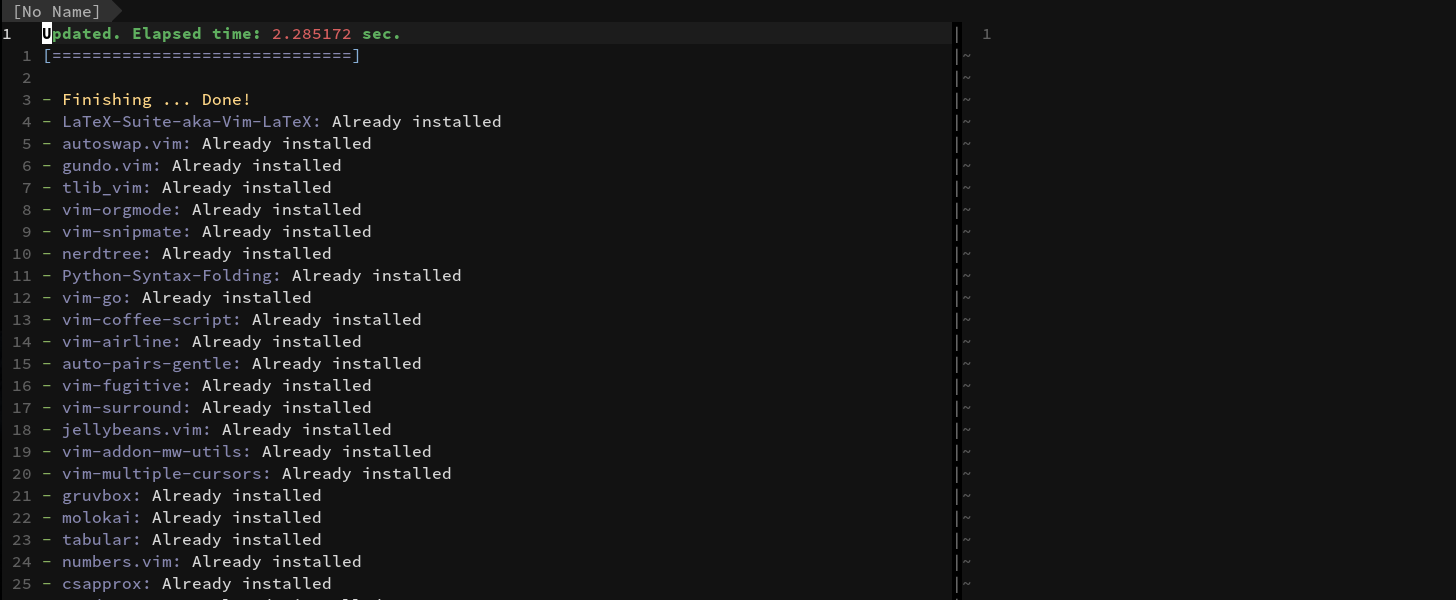Plugin Management in VIM
What I've written in this post is my opinion, and should not be taken as fact. There may be features I don't know about, and my preference order may not be same as yours.
Here is a quick overview of the plugin managers that I've used, ending with explanations on how to use my personal favorite, Vim-Plug. You may skip the comparision section if you just want to be started quickly.
3. PATHOGEN
No discussion of package managers is complete without mentioning pathogen. Pathogen is one of the oldest Package Manager for vim. It simply allows you to clone every plugin into a separate directory inside a bundle folder. This way, all plugins can retain their git directories, and can be updated with proper git commands. All Pathogen does, is ensure that all plugins get loaded at runtime when vim is started.
JUDGEMENT: Too low level. You cannot disable and enable plugins as easily as other package managers, your plugins aren't shown in vimrc.
2. VUNDLE
Vundle is the plugin manager I've used the longest. All plugins
can be listed in your vimrc, and you don't have to clone each one
manually. A simple :PluginInstall takes care of the plugins'
installations. Commenting out a single line from vimrc keeps
that plugin from loading up. Updating plugins and upgrading VUNDLE
is just as easy as the install command.
JUDGEMENT: Vundle has some difficult to remember boilerplate code, and the plugin install is single threaded. On my system, that takes a significantly more time (around 5x) than the multi threaded Vim-Plug.
1. VIM-PLUG
Vim-Plug is a fork of Vundle, and thus has all its features. Apart from that, if your vim is compiled with python or ruby support, or you are using Neovim, Vim-Plug uses multi-threading to clone your plugins in parallel. Vim-Plug also supports lazy loading of plugins, which means that plugins may be set to load only on specific commands, making your vim loadup much faster.
JUDGEMENT: I shifted to Vim-Plug a few weeks ago, and haven't looked back since. I haven't encountered any problems and till now it seems like the perfect plugin manager to me.
Using Vim-Plug Plugin Manager
The good thing about Vim-Plug is that there's no boilerplate code to make it work.
First, let us install Vim-Plug (This only needs to be done once).
Download this
file and place it ~/.vim/autoload
Alternatively, you can use the following command to do it for you. Paste the following inside a terminal.
curl -fLo ~/.vim/autoload/plug.vim --create-dirs \
https://raw.githubusercontent.com/junegunn/vim-plug/master/plug.vim
At the top of vimrc, start the plugin manager with
the command call plug#begin().
This starts the area within which all your plugins will be listed. A plugin is listed in the following format:
Plug '<plugin name>' "If the plugin is on vim-scripts.org
Plug '<username>/<pluginname>' "If the plugin is on github.com
If the plugin is on vim-scripts.org, there would be a mirrored github version which you can find via Google. For example, in case of
https://github.com/vim-scripts/Wombat the corresponding code
will be
Plug 'Wombat' "OR
Plug 'vim-scripts/Wombat'
while in the case of
https://github.com/nanotech/jellybeans.vim the corresponding code
will be
Plug 'nanotech/jellybeans.vim'
Note: Text following " inside vimrc represents a comment.
In case you want to lazy load a plugin, this would be a good place to learn how.
Once you have listed all your plugins, end the call with
call plug#end().
Putting all this together, we get:
call plug#begin()
Plug 'Wombat'
Plug 'nanotech/jellybeans.vim'
Plug 'scrooloose/nerdtree' , {'on': 'NERDTreeToggle'} "Lazy Loading Example
call plug#end()
Put this in your .vimrc and you are good to go.
PRO-TIP: If you are like me, and do not want to do the installation step every time you have to use your vimrc on a new system, you can put the following on the top of your vimrc. It basically checks if Vim-Plug is installed, and downloads the file in the proper place if it isn't.
if empty(glob('~/.vim/autoload/plug.vim'))
silent !curl -fLo ~/.vim/autoload/plug.vim --create-dirs \
https://raw.githubusercontent.com/junegunn/vim-plug/master/plug.vim
autocmd VimEnter * PlugInstall
endif


